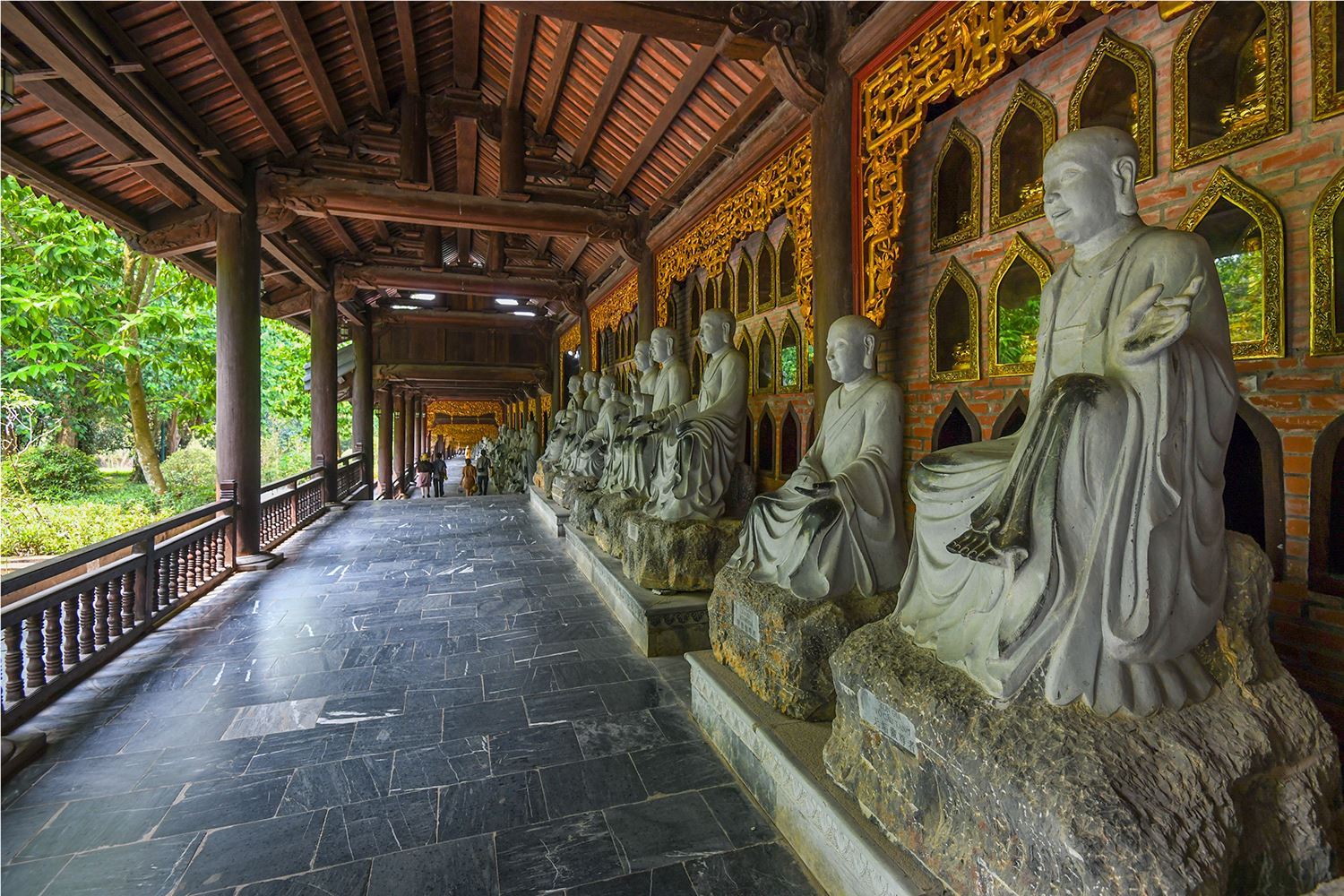Bai Dinh Pagoda is located in Gia Sinh commune, Gia Vien district, Ninh Binh. Not only is it a famous spiritual attraction located in the Trang An eco-tourism complex, Bai Dinh Pagoda is also over 1,000 years old. This place is associated with the history of the land of Ninh Binh from the dynasty of the Dinh Nha Tien Le and Ly dynasties. Becoming a typical landmark for Vietnamese pagoda architecture with many familiar symbols such as the curved roof in the shape of a knife head, the roof with a comedic nose, the decorative stone steps in the style of dragons in the Ly Dynasty...
Weather
Visitors can visit Bai Dinh Pagoda at any time of the year. However, the best time to travel to Bai Dinh is still in spring, from January to March of the lunar calendar. This is a time when the weather is warm, not too hot, nor too cold, extremely favorable for spring travel, rejuvenation and good luck in the new year.
At the same time, this is also the time when the Bai Dinh Pagoda festival and many other local festivals take place in Trang An - Ninh Binh land. You can combine a day of Bai Dinh spring trip on your trip to Tam Coc, Trang An to explore and enjoy Ninh Binh more fully.
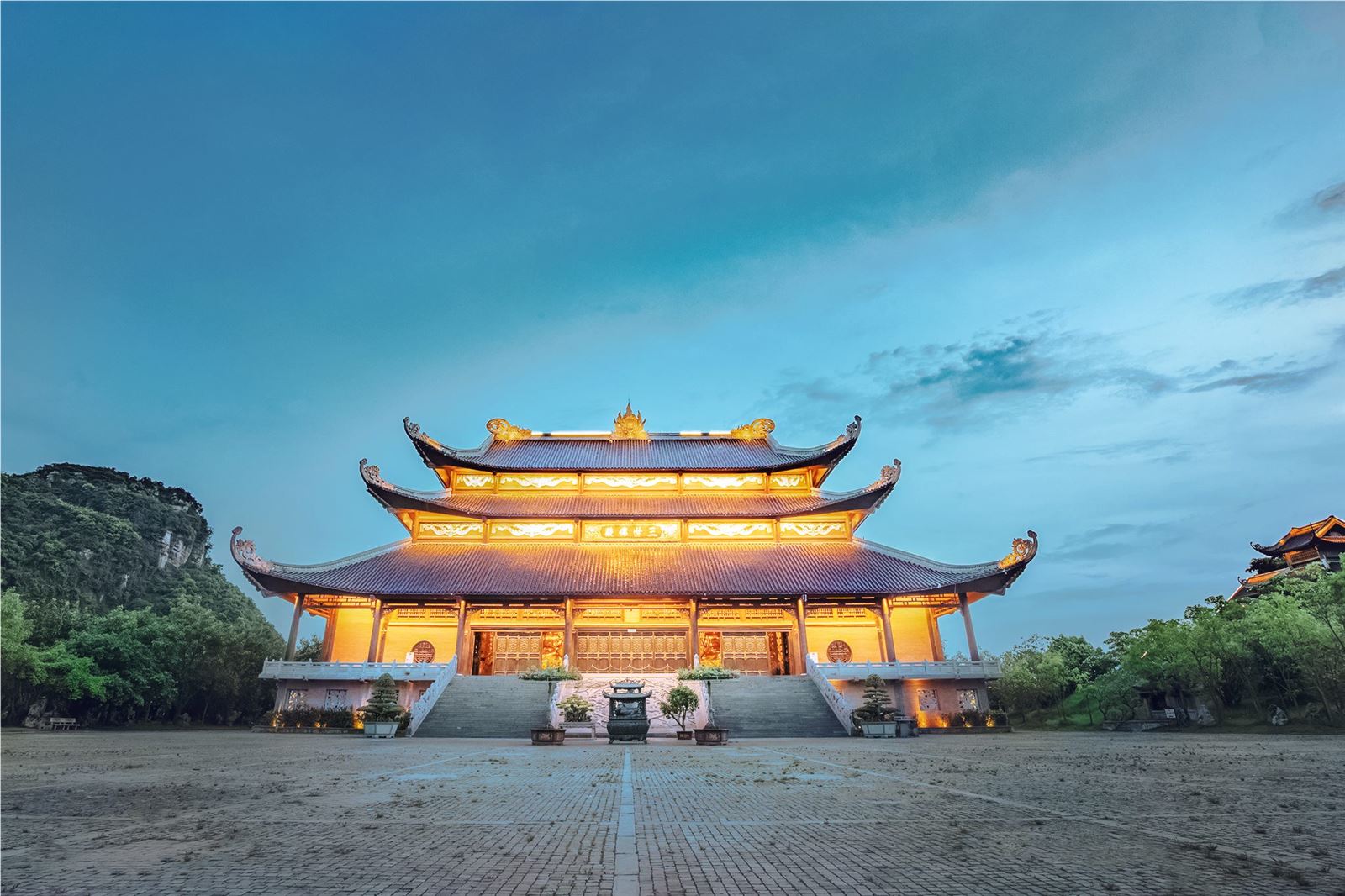
Photo: chuabaidinhninhbinh.vn
Transportation
Ninh Binh is located right on National Highway 1A, extremely convenient to move both by road and rail. From the center of Ninh Binh, you continue about 20km to Bai Dinh Pagoda. Here are 3 common ways for you to move to Ninh Binh.
By bus: From Hanoi, you can take the Hanoi - Ninh Binh bus at My Dinh or Giap Bat bus station with a ticket price of only 70,000 - 80,000 VND/trip. After arriving in Ninh Binh city, you take a bus or taxi to Bai Dinh.
By train
In Ninh Binh, you can get off at Ninh Binh station and from the station travel by bus or taxi to Bai Dinh. Train ticket prices range from 124,000 - 219,000 VND/person/way.
The following is the schedule of some trains from Hanoi to Ninh Binh:
- Train SE7 (6h00) to Ninh Binh (8h14)
- Train SE5 (9h00) to Ninh Binh (11h17)
- Train SE9 (14h30) to Ninh Binh (17h30)
- Train SE3 (19h30) to Ninh Binh (21h44)
- Train SE19 (20h10) to Ninh Binh (22h22)
By private vehicle: This is the simplest and most effective form of transportation. In this way, you follow National Highway 1A, in the direction of Phap Van - Cau Gie to move to Ninh Binh city. The travel time is only about 1 hour. Then from the city follow the directions to Bai Dinh.
Bai Dinh Pagoda has a relatively large campus, you can choose to walk to enjoy a leisurely tour of the pagoda or choose to rent a tram to move to more places. The tram ticket price is 30,000 VND/person/way, the round-trip ticket is 60,000 VND/person.
Popular tourist attractions
Bai Dinh Pagoda consists of 2 areas, namely the ancient Bai Dinh Pagoda (about 27ha) and the new Bai Dinh Pagoda (about 80ha) with many ancient and modern architectural works imbued with Vietnamese Buddhism.
Visit Bai Dinh Ancient Pagoda
Bai Dinh Pagoda was built by Zen master Nguyen Minh more than 1000 years ago in the Ly Dynasty. The ancient pagoda is located entirely on Dinh mountain in Gia Sinh commune, Gia Vien district. Today, the ancient pagoda area has relics such as Sang cave - Dark cave, Thanh Nguyen temple, Cao Son god temple, Ngoc well...
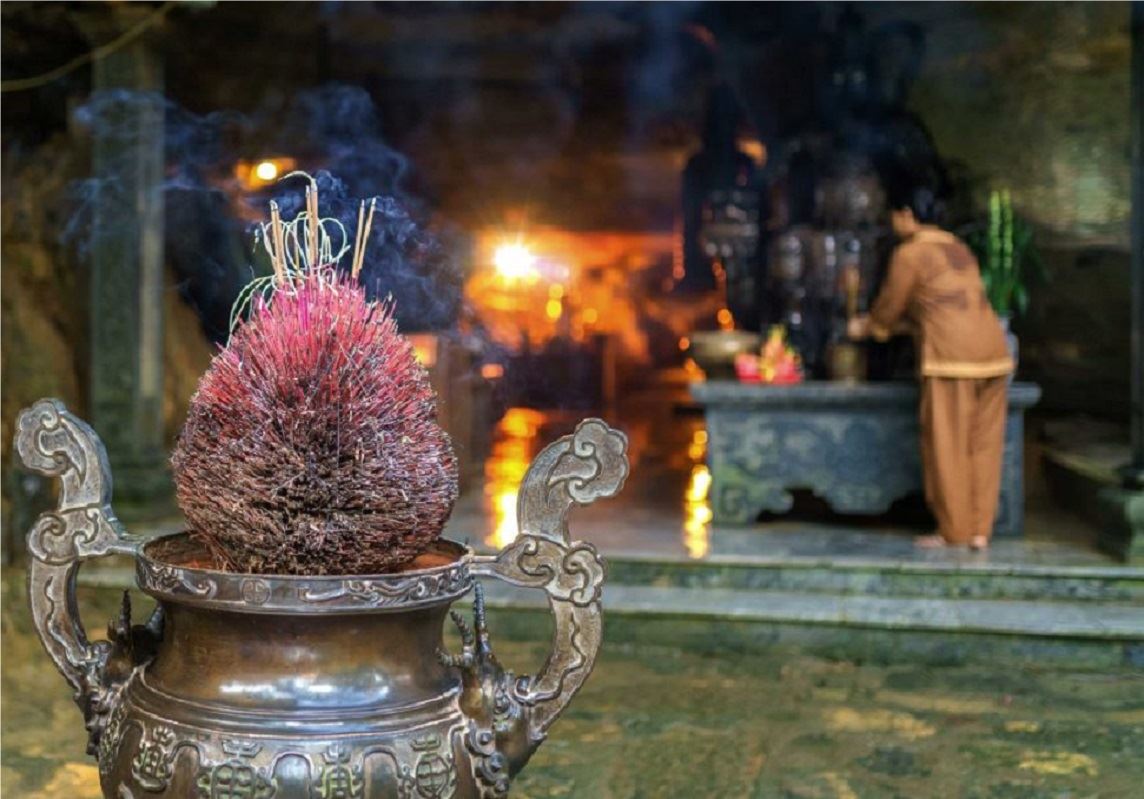
Photo: disantrangan.vn
Saint Nguyen Temple
This place is the temple of National Master Nguyen Minh Khong - who is revered as Saint Nguyen. He was not only a famous Zen master, a famous doctor who held the position of National Master under King Ly Than Tong, but was also revered by the people as the ancestor of the bronze casting profession.
Visiting the temple of Saint Nguyen, visitors not only review a historical figure but also admire the typical sculptures of folk architecture in the sixteenth - seventeenth centuries of Ninh Binh artisans.
Light cave, dark cave
During the journey to overcome 300 steps to the Tam Quan gate of Bai Dinh Ancient Pagoda, visitors will see two junctions next to the slope that are the road leading to Sang Cave and Dark Cave.
Sang Cave is a place to worship gods and Buddhas. There is enough natural light in the cave, so it is called Sang Cave. On the other side of Sang Cave is Dark Cave. As the name suggests, there is no natural light in the cave. Nowadays, people design lighting systems for tourists to visit. From the ceiling of the cave, patches of stalactites cascade down along the underground geysers, creating an extremely interesting scene. The entrance to the cave is decorated with beautifully winding dragon shapes. In the center of the cave there is a natural water well, where statues of Mother and Fairies are placed.
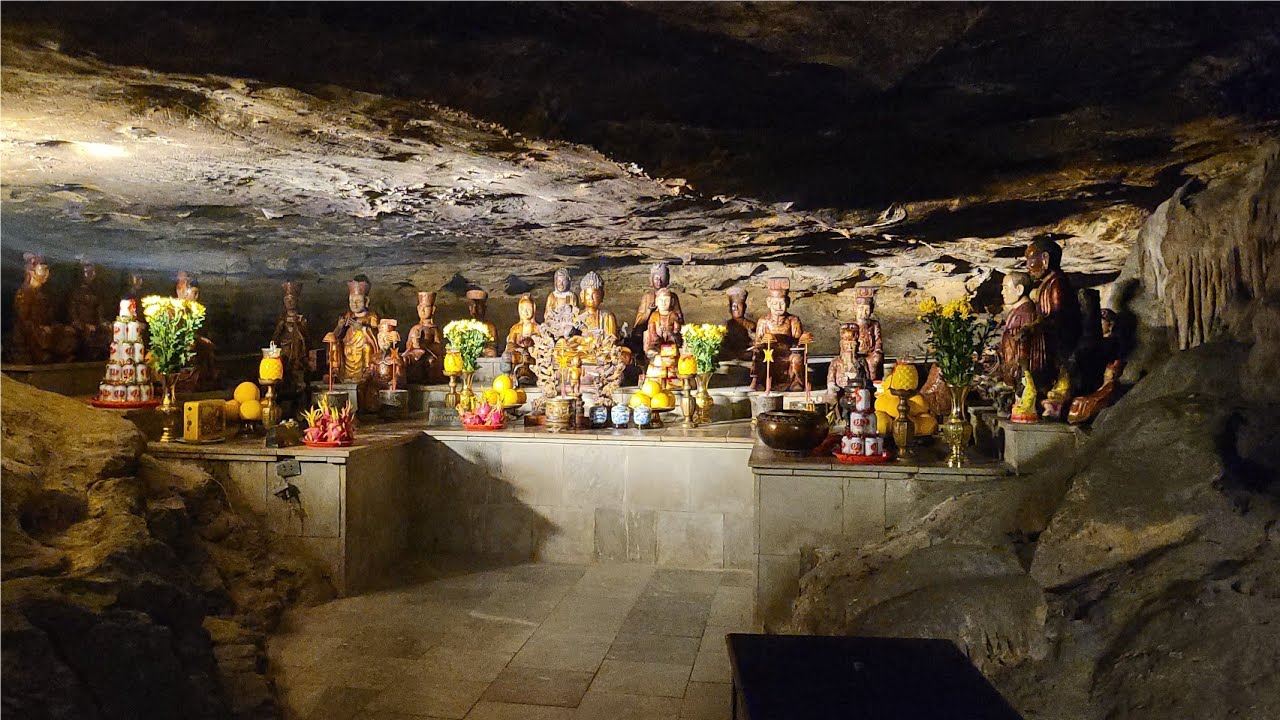
Photo: Youtube Thanh Kho
Jade Well
The jade well is located right at the foot of Bai Dinh mountain, which is recorded as the largest well in Vietnam. Standing in the distance, the jade well like a jade stands out among the surrounding green trees. The well water has never run out, the water is clear, and it is often used as water for worship at the temple.
Temple of the god Cao Son
Going all the way to Sang Cave, you will see a path down the valley slope, leading to Cao Son Temple, worshipping the god who rules the Vu Lam mountains. According to legend, Dinh Bo Linh when he was a child was brought to live in the mountains next to the temple. Later, when he ascended the throne, he built three temples to guard the gateway of the ancient capital of Hoa Lu, namely the temple of the god Cao Son; the temple of Thien Ton and the temple of Quy Minh.
New Bai Dinh Pagoda
Bai Dinh Pagoda was newly built and expanded in 2003 with an area of more than 80 hectares with many works such as: bell tower, Arhat corridor, Mitha Buddha statue, ...
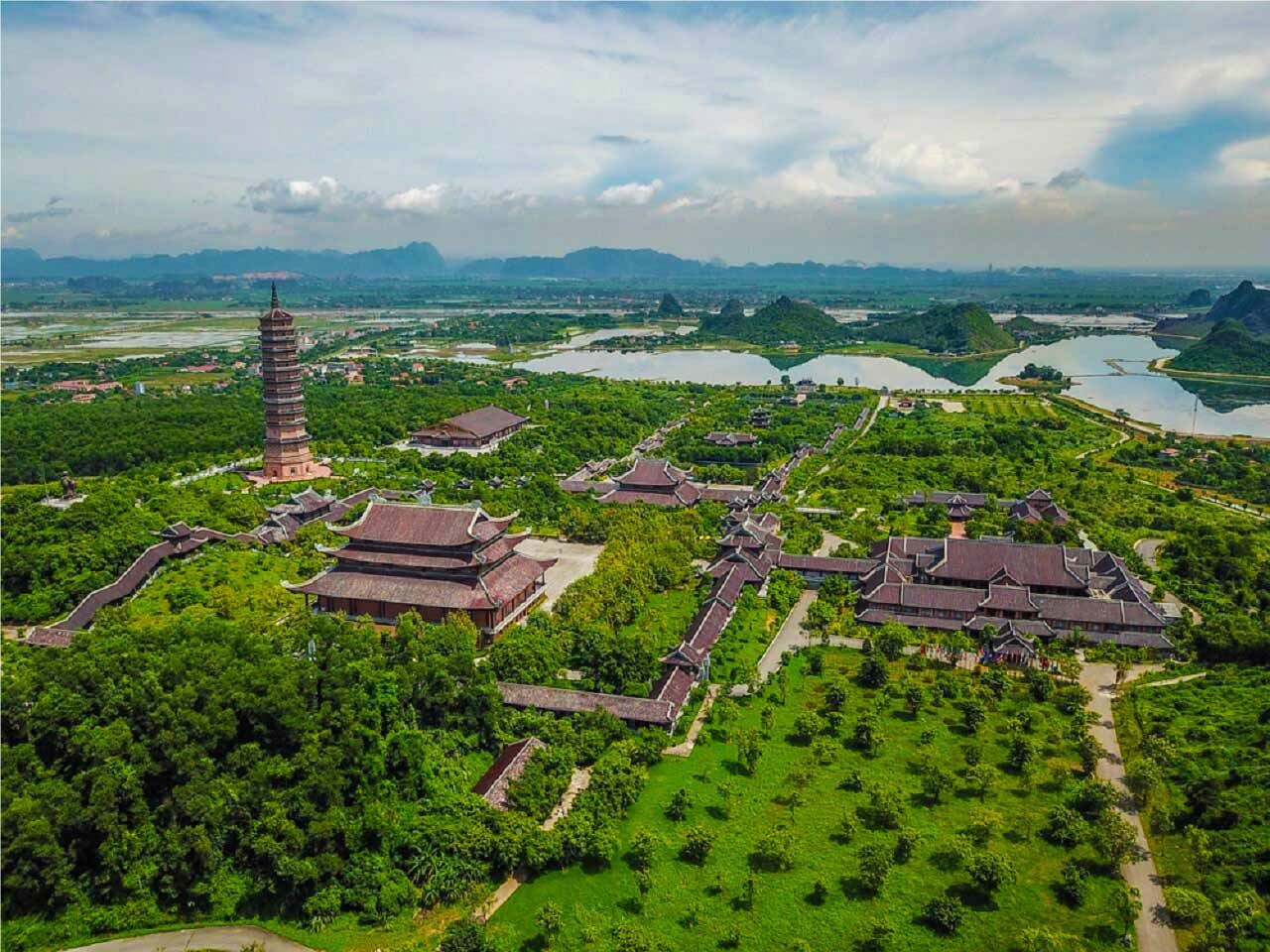
Photo: chuabaidinhninhbinh.vn
Arhat Corridor
One of the must-see attractions when visiting Bai Dinh Pagoda is the Arhat corridor with 234 pavilions connected to the two ends of Tam Quan. The corridor is up to 1052m long with 500 Arhat statues made from monolithic blue stone by Ninh Van stone village artisans. Each Arhat statue has a different shape and posture, representing the ups and downs, joys and sorrows of human beings in the world. Up to now, this is still the longest arhat corridor in Asia on record.
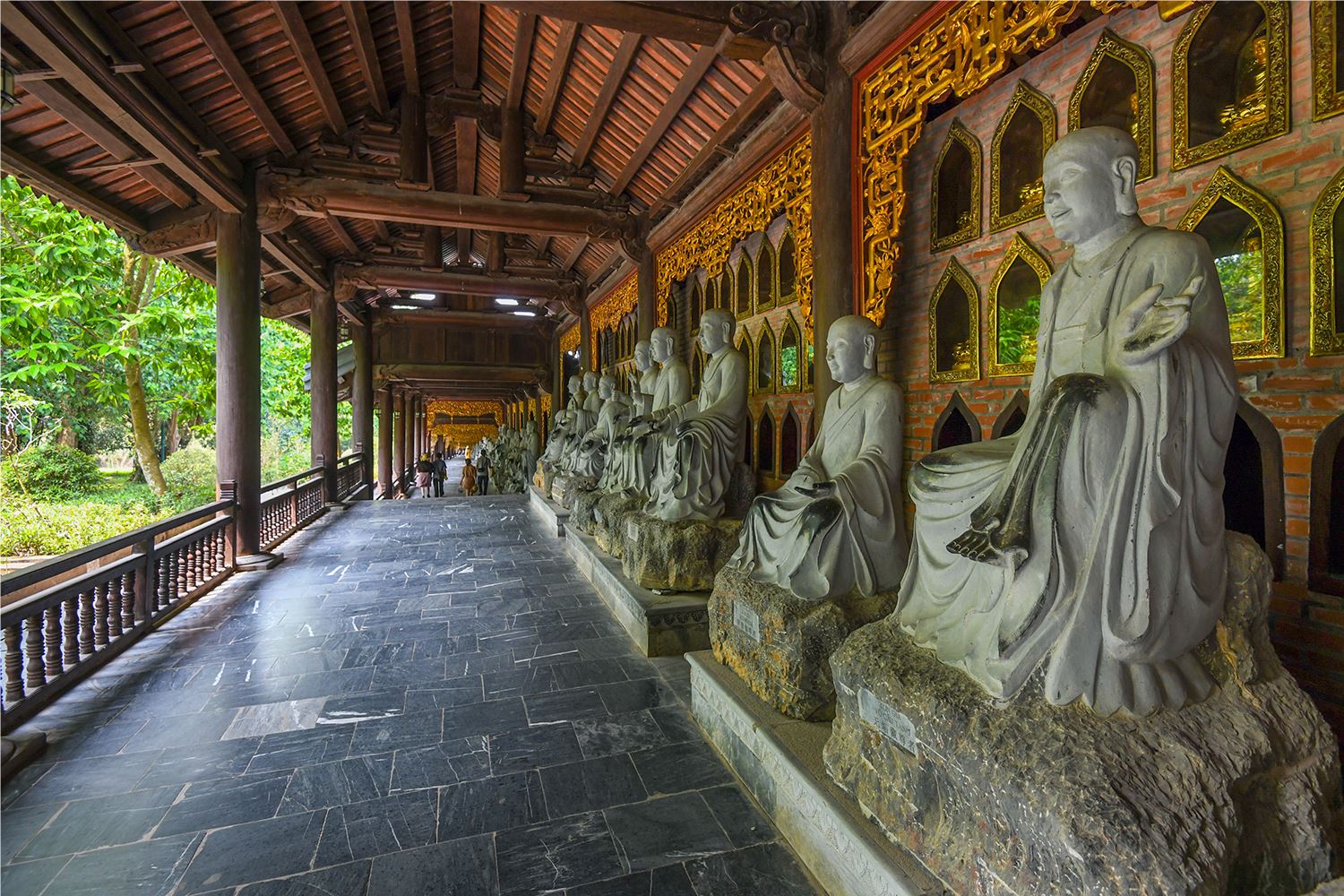
Photo: VnExpress
Belfry
The Bell Tower is one of the famous works of Bai Dinh Pagoda. The octagonal tower is built in an architectural style that mimics ancient bell towers with imitation timber reinforcement structures. Inside the bell tower is a bronze bell weighing 36 tons with many extremely vivid decorative motifs, which is confirmed as the record "The Largest General Red in Vietnam".
Buddha Relic Tower
After walking all the way through the Arhat corridor, located on the west side of the Tam The Hall, visitors will observe the 13-storey stupa that stands out in the middle of the temple grounds. This is where Buddhist relics brought back from India and Myanmar are kept.
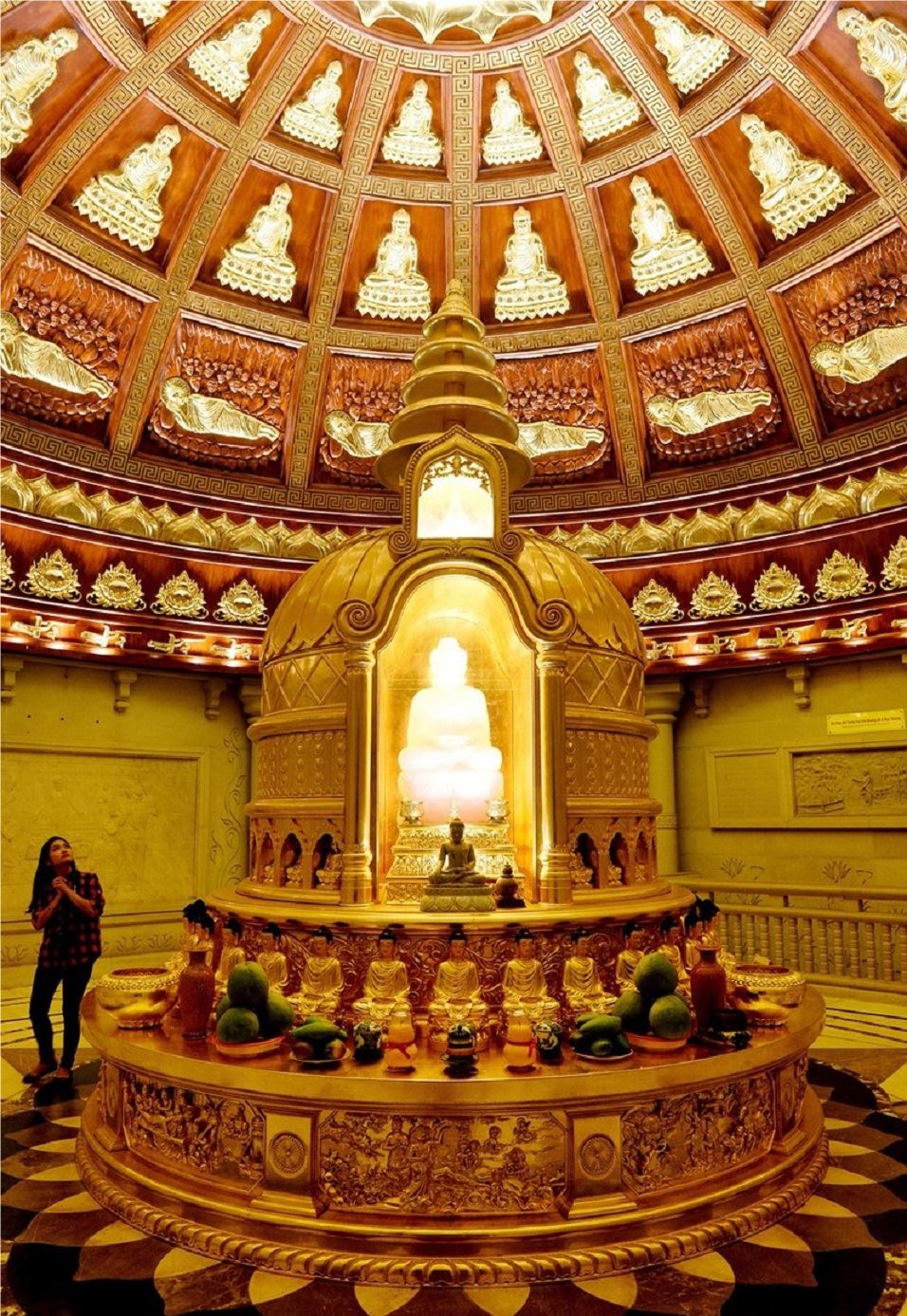
Photo: baophapluat.vn
The Dharma Lord's Palace
The Dharma Lord's Palace is a place to worship the Buddha, which was built extremely grandly. This is one of the massive works with a total area of up to 1,945m2 with 2 floors of curved roofs, 8 roofs on four sides and a row of ancient buildings to raise height and get light. Only the sword bank is up to 1m3 high, the roof is 2m6 high, the moon at the top of the roof is up to 4m4, and the tip of the pliers is 3m3 high.
Guanyin Palace
The Quan Am temple consists of 7 compartments, made entirely of wood. In the center is a statue of Guan Yin Chuan De with a thousand eyes and a thousand hands cast in bronze weighing up to 80 tons. The statue was confirmed by the Vietnam Record Book Center as "The largest bronze statue of Guan The Yin Bodhisattva in Vietnam".
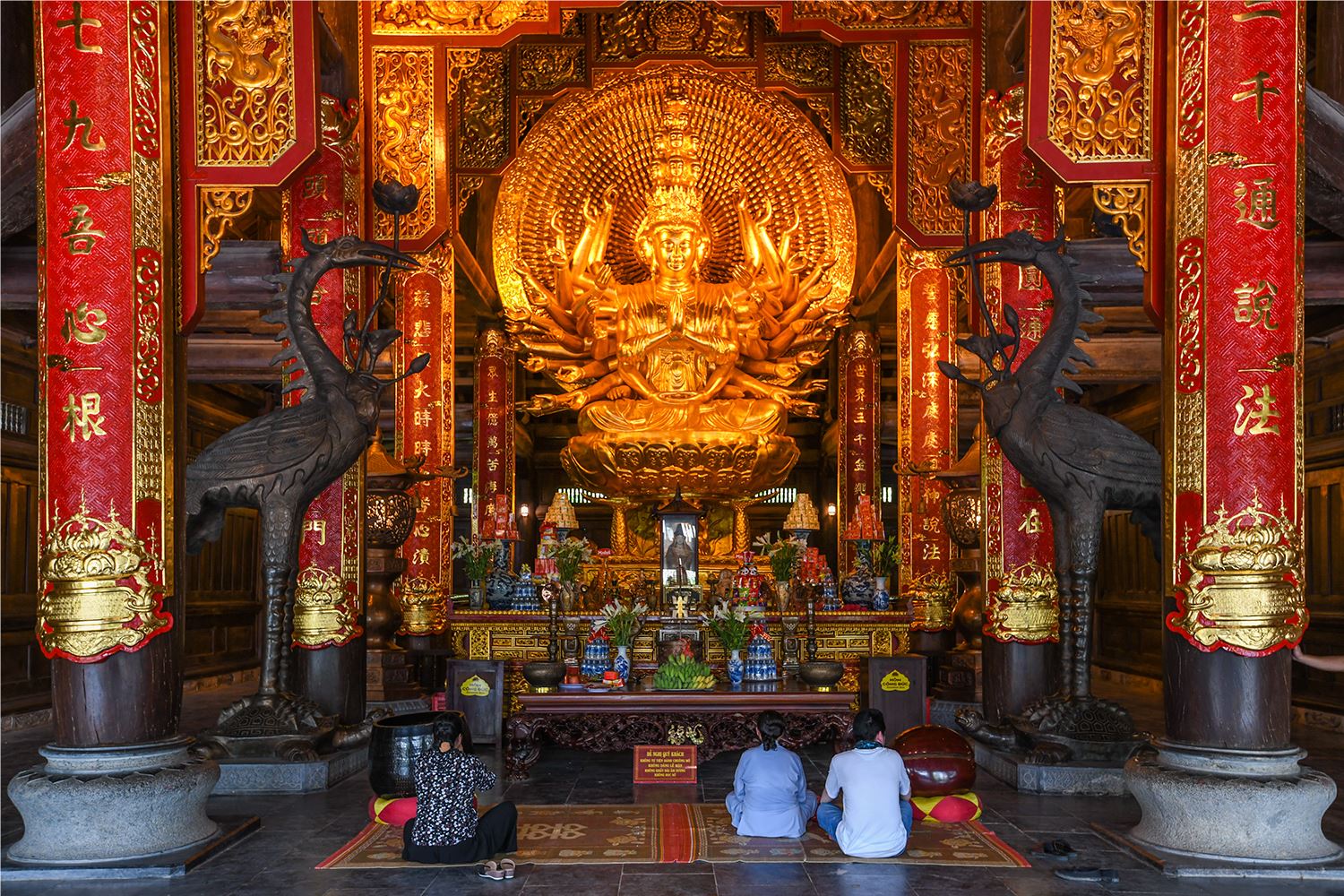
Photo: VnExpress
Visiting Bai Dinh Pagoda, visitors can stay at resorts and hotels such as: Bai Dinh Hotel, Ninh Binh Eco Garden, Ninh Binh Family Homestay, Ninh Binh Mountain Views Homestay, Bai Dinh Riverside Resort & Spa,... And after visiting the pagoda, stop to enjoy vegetarian rice or specialties with bold Ninh Binh characteristics such as elder rice, mountain snails, goat meat, eel vermicelli... In the following, Migo would like to suggest a few places with delicious, affordable cuisine that are passed on by many tourists:
- Thang Long Restaurant: Trang An, Chi Phong Village, Truong Yen, Hoa Lu District, Ninh Binh
- Duc De Restaurant: 29 Doan Ket Street, Ninh Phong Ward or Ring Road, An Hoa Street, Ninh Phong Ward, Ninh Binh City
- Hoang Giang Restaurant: Hang Ca Mountain, Truong Yen, Hoa Lu District, Ninh Binh
- Dat Set Restaurant: near Ninh Binh Provincial Gymnasium, Street 11, Dong Thanh Ward, Ho Chi Minh City. Ninh Binh
- Ba Phan eel vermicelli: 995, 997, 999 Tran Hung Dao, Ninh Binh City.

Photo: agoda
As one of the spiritual tourist attractions, when visiting Bai Dinh, you need note the following points:
- Wear discreet clothes, collared shirts, long pants, no short skirts or revealing clothes when visiting the temple
- It is recommended to wear sneakers to avoid foot pain during the journey
- Do not buy souvenirs on the temple premises
- Do not eat, drink, litter indiscriminately on the temple premises, causing loss of aesthetics.
- You can bring change to pray for good luck for yourself, friends, and family
- Bring umbrellas and hats. If you go on the first day of spring, you may encounter drizzle, you should bring an umbrella.
- Put the donated money in the right places such as donation boxes, do not put it on the Buddha statue, to avoid losing its beauty.
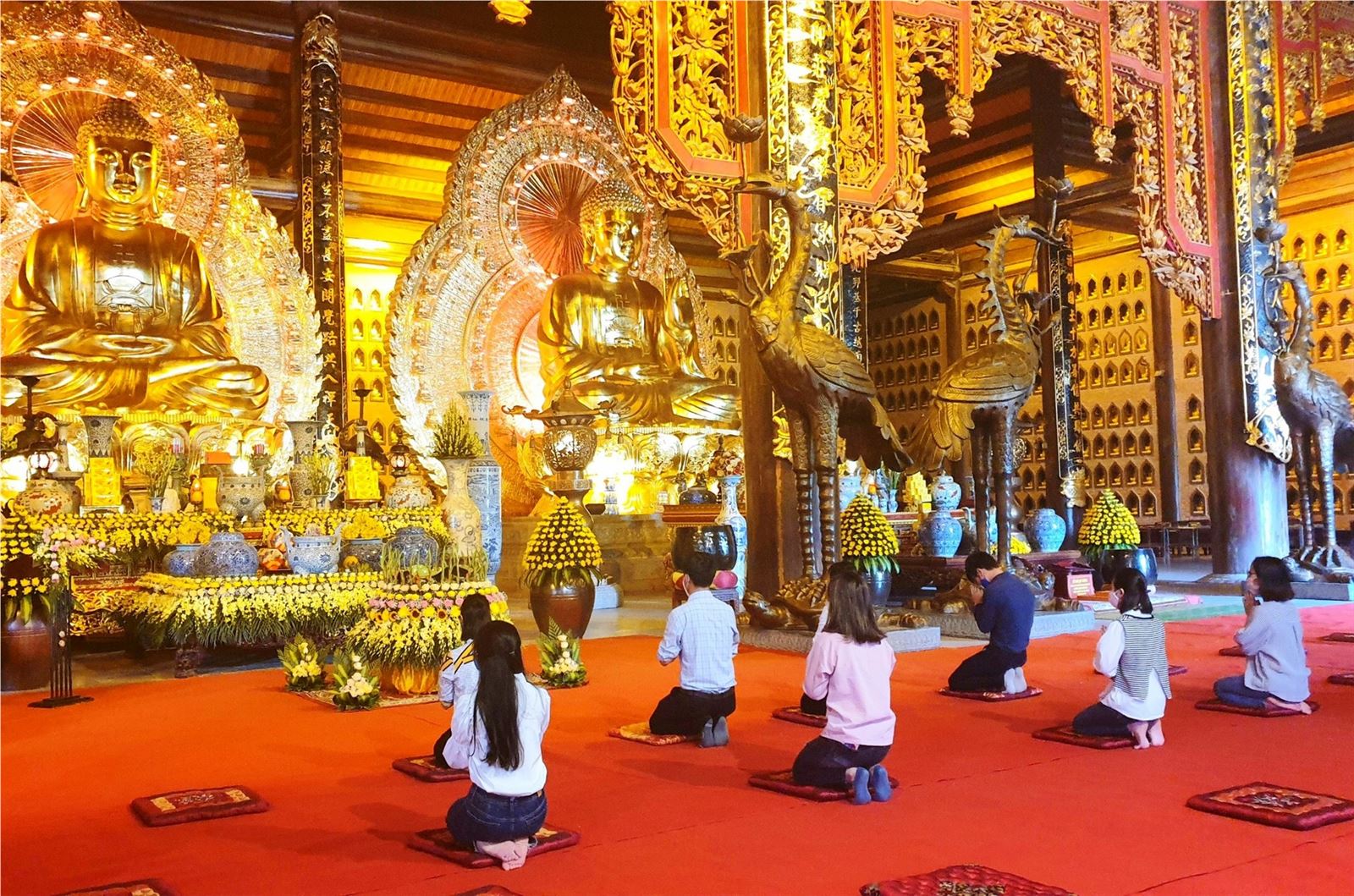
Photo: laodong.vn
Synthetic Migo
